What is a user journey in app development?
A user journey is a series of planned steps that map out how users interact with your app, helping you to identify weak points and optimize the user experience.
Try searching for
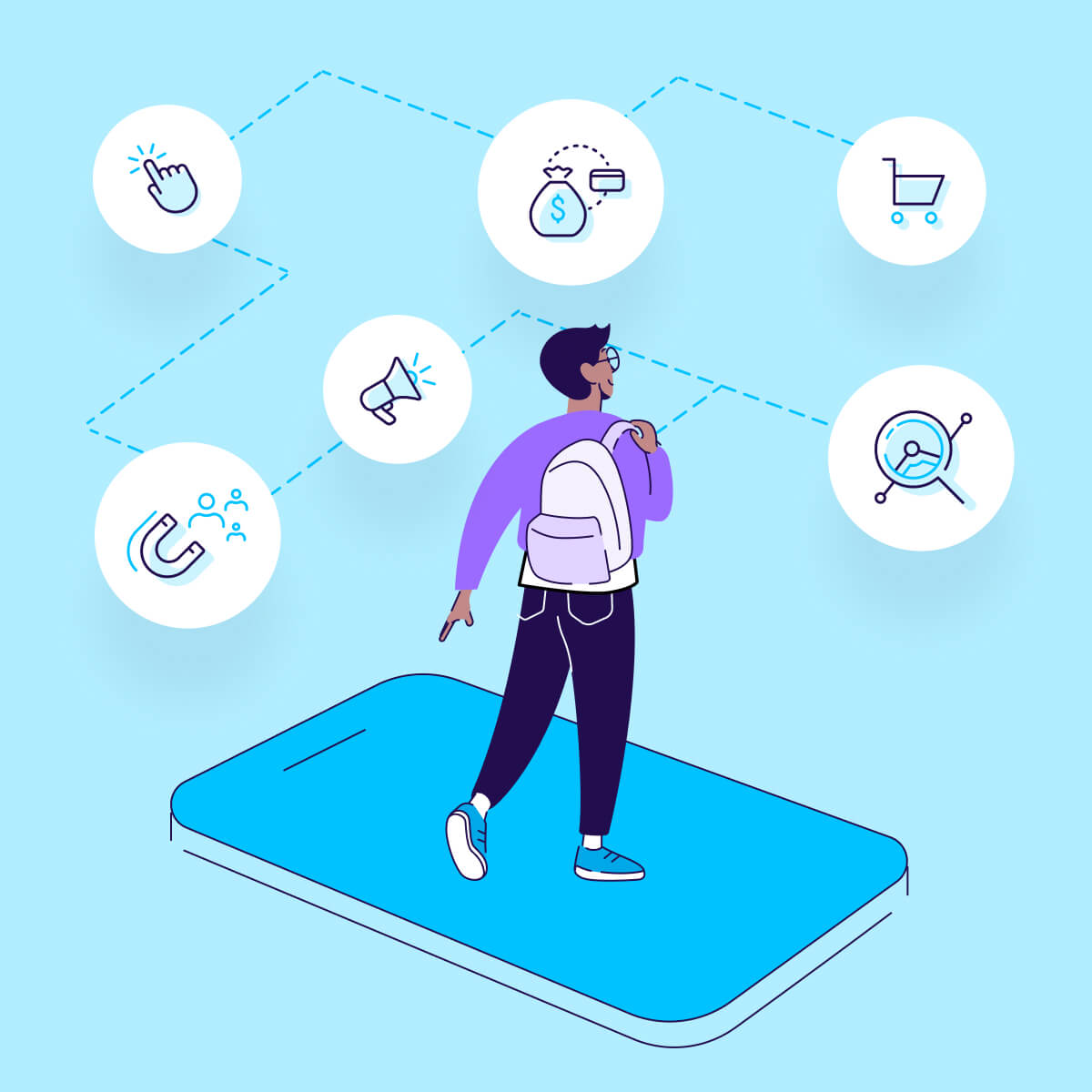
How do you ensure users are using your app in the best possible way?
Your approach to this burning question can be the game-changer between a stellar app with a massive and engaged user base and an impractical one that’s left collecting digital dust.
When users first lay eyes on your app, it needs to leave a lasting impression. It should offer a perfect blend of impact and simplicity, enabling users to effortlessly navigate through the app while accomplishing the desired actions.
But achieving this doesn’t happen on a whim. The key is to eliminate those pesky pain points that make users want to throw their devices out the window. That’s where the magic of mobile app user experience (UX) comes into play, as you strategically optimize your app in various ways.
And guess what? It becomes a whole lot easier when you map out the app user journey.
The user journey is a series of carefully planned steps outlining how you intend users to interact with your app.
This crucial concept in the realm of app development involves closely examining user behavior to identify any weak points along the path to achieving your desired goals. For example, for a meditation app, the end goal is typically daily engagement, while for an eCommerce app, the end goal might be to complete a purchase.
When we talk about weak points, we mean issues that may cause users to stumble, hesitate, or lose their way. For instance, they may hesitate to explore new features or struggle to grasp certain functionalities.
Mapping out the user journey helps you effectively address these pain points, ultimately enhancing user experiences.
App user journeys can unlock the full potential of your app by helping you understand user behavior, pain points, and desires. Based on these insights, you can optimize your app’s design and functionality to create valuable user experiences that cultivate long-lasting engagement with your target audience.
In fact, it’s fair to say that launching an app without user journeys is a blind gamble.
You may get occasional insights from interviews or product analytics, but you’re likely to miss out on important revelations. User journeys give you a comprehensive collection of user experiences that you can intentionally explore through analytics experiments and interviews. This makes it easier to uncover crucial issues before they turn into big problems.
Here’s a quick rundown of the main benefits of app user journeys:
User journeys allow marketers and developers to dive deep into their target users’ hearts and minds.
By mapping out the user journey, you can deeply empathize with users, gaining a comprehensive understanding of their problems, needs, feelings, and desires at different stages of app interaction. This understanding empowers intentional changes that address pain points and provide irresistible value, resulting in a more user-centric and engaging app.
User journeys guide data collection and analysis, enabling you to observe users’ paths in detail. You get to observe the intricate paths users take, uncover patterns, stumble upon pain points, and spot golden opportunities for improvement.
Armed with this data, you can run intentional experiments and interviews to reveal valuable insights and prevent issues from escalating.
Understanding how users interact with your app enhances their overall experience.
Tracking the user journey helps you determine whether your app effectively solves users’ problems, meets their goals, and provides a seamless experience. This knowledge drives continuous improvements, allowing you to optimize features, usability, and design to create a truly valuable and enjoyable app.
App user journeys also help you define and target the app’s ideal audience.
By researching goals, challenges, and user journeys, you can gain clarity about your target users and how your app addresses their specific problems. With this knowledge, you can then craft effective marketing strategies, tailor captivating messaging, and better align your app’s value proposition with the target users’ needs.
When an app aligns with users’ goals and consistently delivers value, users are more likely to remain engaged and loyal.
Analyzing the user journey helps you identify potential friction points or gaps in the onboarding process that may lead to user abandonment. You can use the insights you gain to create a smoother onboarding process and an improved user experience, ultimately boosting retention rates.
User journey maps foster collaboration across different teams, ensuring a user-centric approach. In fact, product development, sales, and marketing teams all benefit from understanding the user journey. The insights help teams align their efforts and vision, synchronize their talents, and build an app that resonates deeply with the target users.
App user journeys focus specifically on a user’s interactions within your app, from downloads to use of features and functionalities.
This differs from the customer journey, which encompasses the broader experience that includes all touchpoints — digital and physical — with your brand, going beyond app usage. With customer journeys, you’re considering solutions to pre-app interactions, app usage, and potential post-app engagements.
The user journey is a part of the customer journey — and so are the user flow and user funnel. However, they’re each distinct terms that cannot be used interchangeably.
Let’s discuss them in more detail below.
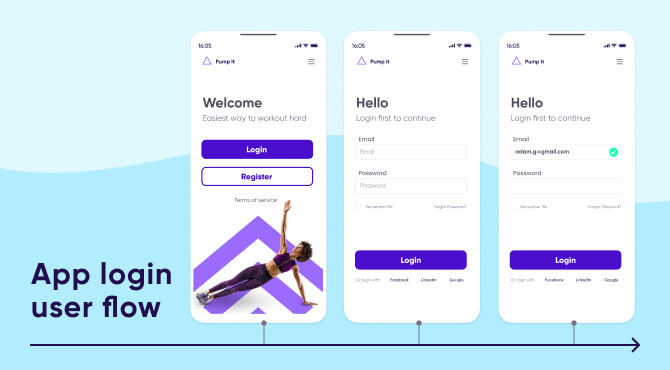
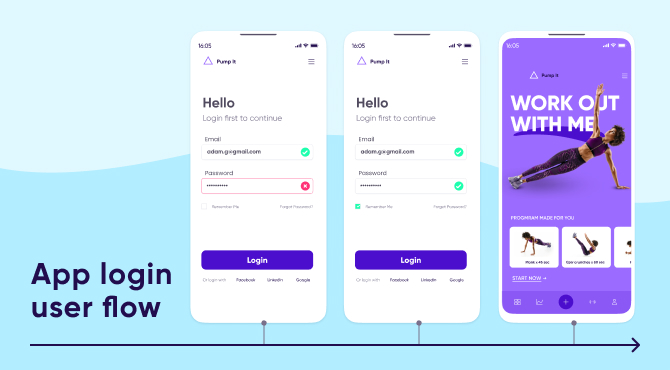
Crafted by UX designers, user flows include the intricate micro steps required to achieve specific actions within your app’s user interface. Take, for instance, a simplified login flow:
Opening the app ➡️ Tapping login ➡️ Entering email address and password ➡️ Tapping login again ➡️ Responding to error messages (if necessary) ➡️ Seeing the display of login success message and app home screen
While user journeys may reference these steps, their purpose lies in extracting valuable insights regarding user experiences at each point of the login. Did they find the process easy? Or did they tap the wrong button, take multiple attempts, or give up altogether? These insights, in turn, fuel improvements in future flows.
Consider a high-level user journey, such as making a purchase. This may combine the entire login flow as a single step: Login. Your goal here is to evaluate user sentiments, desires, and other perspectives, ultimately driving enhancements in encouraging purchases at a broader level, including potential tweaks to the login flow.
On the other hand, a more detailed user journey, such as one focused exclusively on login, will deeply analyze each step of the user flow to optimize the login process. It goes beyond a mere flow chart, encompassing all the previous user details. This comprehensive approach helps create an improved login experience, ensuring a smoother journey for users going forward.
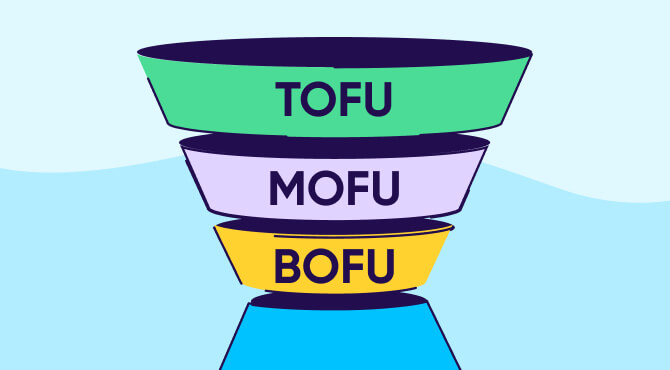
User funnels serve as a distinct tool for tracking users through a series of steps, but they have different purposes compared to flows and journeys.
For example:
While user flows and user journeys share similarities with funnels, the distinction lies in their focus and level of abstraction.
Sales and marketing funnels can be considered as steps in a user journey, depending on the level of detail in mapping. In addition, funnels generally represent the overall steps completed by all users, from lead generation to customer conversion. That’s why we talk about ‘top of funnel’ (awareness) and ‘bottom of funnel’ (conversion) activity.
On the other hand, user journeys focus on the specific steps and user reactions of a particular user segment or persona, whether it’s their journey towards a purchase or sharing the app with others.
In a nutshell, funnels serve lead generation and conversion purposes, whereas user journeys provide a more granular understanding of user interactions and experiences within the app, tailored to specific user segments or personas.
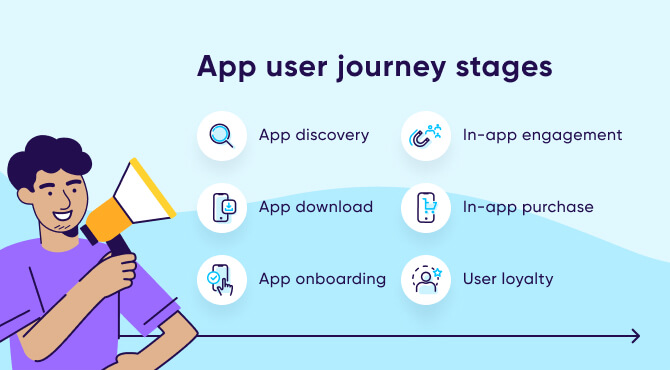
User journey stages may differ depending on your app monetization model and category. For example, a free gaming app with multiple levels will have a different user journey than a meditation app that offers in-app yoga classes for purchase.
While each user journey is unique, apps share certain common stages. Here are the core steps outlining an effective user journey, as the user progresses from discovery to purchase:
The app discovery stage has users exploring various app options before deciding to download. With countless apps available in app stores every day, you must prioritize app store optimization (ASO) and referral marketing campaigns to increase visibility and encourage users to choose your app and share it with their networks.
This stage is crucial for your app’s growth and success. It marks the first conversion point in the user journey, where users take action and download the app.
In addition to optimizing your app store listing, identify the main factors that can build trust and convince new users to download your app. These can include limited alternatives, positive reviews, and unique features. Then optimize your user acquisition strategies and personalize marketing campaigns to improve conversion rates.
A well-designed app onboarding experience makes it more likely that users will keep using your app for a long time. Users understand your app’s value proposition, learn key features, and grant the necessary permissions. It reduces any difficulties or confusion they may face and familiarizes them with the app’s interface.
This guided assistance allows them to explore and use all of your app’s features effectively.
This stage is crucial for keeping users engaged and loyal. Many users tend to churn after the initial onboarding stage, so boosting engagement becomes vital for long-term app growth and profitability, especially considering the high costs of acquiring new users. It also drives in-app purchases (more on these below).
To achieve this, focus on promoting the adoption of key features and increasing the number of active users on a daily, weekly, and monthly basis. You can also use in-app messaging channels to help users with useful tips, reward engagement, and continuously deliver value that keeps them coming back for more.
Following the initial app download, in-app purchases become a significant milestone and primary objective in many user journeys.
The importance of in-app purchases varies based on your monetization model. Freemium apps, for instance, rely on a small portion of users for revenue. So, instead of targeting all users, focus on nurturing the most lucrative ones. Knowing the user segment to reach this goal will help you better plan your app’s user journey and messaging.
Once an in-app purchase has been made, your next step should be to encourage repeat conversions. Use email, push notifications, and in-app notifications to follow up, provide recommendations, and personalize the experience. Be sure to choose the right communication channel and timing for each case to optimize your messaging.
Note that not all apps rely on in-app purchases. Some generate revenue through ads or data collection. In such cases, user loyalty and retention become the end goal. By enhancing engagement and retention, you can expand the ad audience and increase revenue for free apps that feature in-app advertisements.
As users progress through your app’s user journey, their needs, goals, and expectations evolve. This makes personalization even more crucial.
Tailor purchase recommendations, app experiences, and promotions based on each user’s preferences. Refine your messaging strategy with targeted approaches. Leverage advanced segmentation and personalization features to ensure the app evolves at the right pace for each user.
You can also create a supportive community where users can showcase their achievements to make them feel valued and keep them engaged as loyal users.
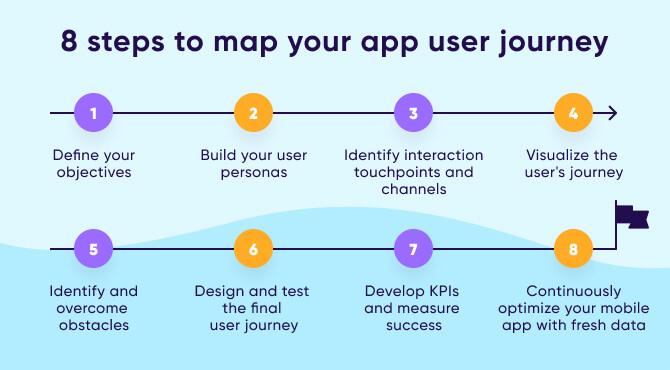
An app user journey map reflects the entire path of interaction between the user and the app. Follow the steps below to better understand user goals, motives, expectations, and fears and optimize your app experience accordingly .
Before diving into mapping your user journey, it’s crucial to define your objectives.
Decide if you want to focus on the entire user journey or just one aspect of your app experience. This will give you a clear direction for your research — what to track and how to enhance your app. You can also involve different teams like product development and marketing to define objectives, leveraging their knowledge about various aspects of the app.
Create fictional representations of your target users, including their unique characteristics and attributes, based on in-depth research. Collect feedback from current customers and ask them about their experience with your app. This includes how they discovered your app, their touchpoints, goals, challenges, and decision-making influences.
Understanding your audience is key to building a valuable app. Once you’ve gathered insights, develop user personas with names and even visual representations for clarity. Share these personas with all teams involved in building a successful app.
Next, map all the touchpoints where users come into contact with your app. The more touchpoints you include in your journey map, the clearer the picture becomes. Examples of communication channels are push notifications, websites, search engines, other mobile apps, email marketing, and social media.
To cover all possible touchpoints and channels:
Visualize how users engage with your app, from their initial encounter to conversion. Capture their thoughts, emotions, and actions throughout this journey. You want to understand how your app fits into their daily life and how it helps them solve problems.
Keep in mind that each user persona requires its own specific user journey, so don’t rely on a generic one. Different personas have unique needs and challenges, so tailoring the user journey to each persona is essential.
Now that you have an idea of what a user’s journey looks like for your app, pinpoint the challenges and critical points that may hinder users from transitioning between journey stages. For example, a user wants to make an in-app purchase but is asked to sign up, which frustrates them and leads to abandonment. Inconvenient registration processes and unclear calls to action are also potential obstacles.
List all obstacles and brainstorm ways to remove them. And if the user journey changes after implementing new solutions, create a new journey to evaluate the results.
Consolidate all the data you’ve collected into a comprehensive map that includes the list of user steps, success criteria for each step, retention rates, conversion rates, interaction points, obstacles, and ways to overcome them.
But don’t stop there: after mapping the user journey, you need to test it firsthand to fully understand your users’ experience — and make necessary improvements based on your findings.
To move forward with your goals, it’s essential to measure the success of your user journey.
Develop clear key performance indicators (KPIs) to evaluate the performance of each user journey. Track mobile app metrics such as active users, cost per acquisition, conversion rate, retention rate, and lifetime value. By analyzing these metrics, you can evaluate the effectiveness of your marketing campaigns and user personas, and identify specific areas that require improvements in your user journey.
App optimization is a constant effort. Always look for ways to make the user experience better and meet the needs of every user persona. This could involve removing unnecessary steps in the user journey or finding ways to keep users engaged for longer.
Consider conducting A/B tests to help you fine-tune and enhance your app’s performance. Remember, there is no final destination when it comes to optimization. You have to keep collecting insights, analyzing data, and refining your app to create an even better user experience.
A user journey is a series of planned steps that map out how users interact with your app, helping you to identify weak points and optimize the user experience.
User flows focus on specific micro-steps within the app interface, such as logging in. User journeys, on the other hand, analyze the broader user experience and emotional responses at each interaction point. Insights from your user journey can help you improve specific user flows, for example simplifying a process.
The core stages include app discovery, download, onboarding, in-app engagement, in-app purchase, and user loyalty.
User journey mapping helps you understand user behavior, pain points, and desires. This enables you to optimize the app’s design and functionality to create valuable experiences that drive long-term engagement.
Mapping your user journey starts with defining your objectives and building user personas. Then, identify touchpoints and channels, visualize the journey for each persona, and find and overcome obstacles. Design and test your journey, then measure success against your KPIs and keep optimizing the experience.
Success is measured through KPIs like active users, cost per acquisition, conversion rate, retention rate, and lifetime value.